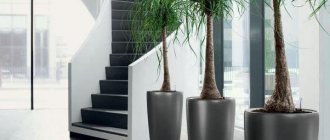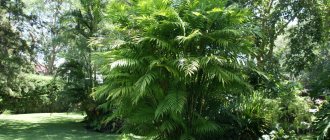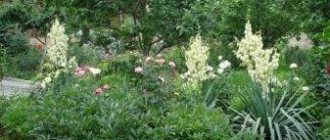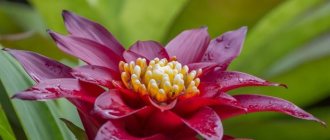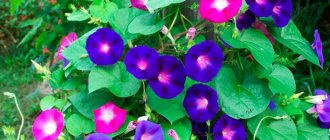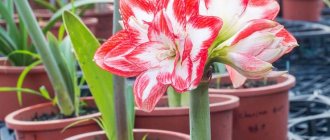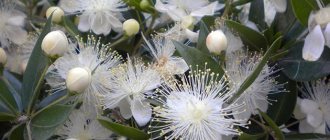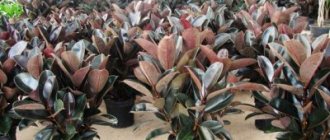You can only grow one type of coffee at home: Arabian. A plant of this species has wavy, smooth oval leaves with a sharp tip.
For a young tree you need to choose the right permanent location. The plant does not like unnecessary movements - even a slight change in its position in space will cause the leaves of the coffee tree to fall off.
The coffee tree needs a very bright place, but not direct sunlight. In partial shade, the plant will hurt and look pitiful. Irrigation and water quality are important. This plant does not like drying out or waterlogging the earthen clod. The soil must be selected very carefully: use peat or coconut substrate and regularly feed it with fertilizer that does not contain calcium salts. Leaves can dry out from lack of light and humidity, as well as from drafts. For good care, the coffee tree will thank you with real Arabian coffee beans!
Calculate the exact cost of repairs using an online calculator
and receive a free detailed estimate for repairs
Calculate
Photo: sovetnews.com
Types of indoor trees and breeding conditions
Large plants in tubs perfectly decorate the interior. With proper watering, they provide lush greenery all year round. Of the existing species diversity, preference is often given to some variety that is undemanding in care. We’ll tell you in more detail about which specimens can be bred at home.
With constant employment, spending free time on hobbies and hobbies is an unaffordable luxury. Unpretentious varieties that do not require special conditions for growth and flowering are popular among apartment and house owners. The following varieties are common:
- citrus fruits (lemon, tangerine, orange, kumquat);
- exotic (breadfruit, bamboo, shefflera);
- ficuses (Benjamina, Bengal, rubber);
- palm trees (date, banana, rapis);
- bonsai (pine, spruce, sakura);
- flowering (hibiscus, abutilon).
The owners decide for themselves which species to give preference to. When making a choice, you should take into account the nuances. You need to determine in advance where the flower pot will be located. For the plant to be healthy, there must be enough lighting in the house. You should choose a flower carefully if there are small children and animals in the house. Some of the plants contain harmful substances that are hazardous to health.
Ficus
There are more than 20 species of domestic trees of the ficus genus. They vary in shape and appearance. An unpretentious plant does not require frequent watering and feeding. It cleans the air well, neutralizing benzene, formaldehyde and other harmful substances. Some ficus trees are poisonous. They should not be kept in a home where there are children and pets.
Ficus rubber produces volatile substances that are harmful to asthmatics. It is not recommended to place it in the bedroom and nursery.
Ficuses with large, juicy greens forming a dense crown look beautiful in the interior. The following varieties of ficus are optimal for home interiors:
- Ficus Benjamin;
- rubbery;
- lyre-shaped;
- Ficus Binnendieck;
- ampelous;
- Bengal;
- dwarf;
- bottle.
Ficus is one of the most common indoor plants. It can often be found in apartments and offices. To make the flower look healthy, it is enough to water it abundantly from time to time.
Dieffenbachia
It grows up to two meters in height. The motley guest from the sunny tropics is demanding in care. She cannot stand drafts and cold. Uneven watering leads to yellowing of the leaves. In order for the leaf to retain its rich green color, it is necessary to spray with warm water.
Dieffenbachia can liven up a boring apartment interior. But not everyone knows that its juice is poisonous. When it comes into contact with human skin, irritation occurs. If the juice splashes into the eyes, vision problems may occur. In a family where there are small children and animals, Dieffenbachia should not be bred.
Boxwood
The evergreen beauty grows up to 12 m in height. Garden boxwood can be grown in an apartment. Dense greenery, forming a dense crown, will decorate the design in an oriental style. Do not forget that boxwood is considered a long-liver. With proper care, it will delight its owners for many years.
The planted sprout grows slowly, up to 5 cm per year. Around the columnar trunk, many shoots are formed, covered with small glossy leaves.
There are more than 50 varieties of boxwood. The following varieties are suitable for growing at home:
- evergreen;
- small-leaved;
- Balearic.
The evergreen beauty requires circular pruning. Boxwood branches grow quickly. Regular pruning gives the plant a well-groomed appearance. A compact boxwood figure will be a wonderful decoration for an apartment or office. This decorative beauty perfectly purifies the air. It should be remembered that its stems and leaves are poisonous. It is not recommended to place boxwood in a nursery. Greens are also dangerous for pets.
The most beautiful and popular varieties grown at home
Of the many clerodendrums, 15–20 species are most often found in indoor floriculture.
Mrs. Thompson's clerodendrum (Thomsoniae)
This species is a climbing vine with shoots that quickly become woody at the base. The leaves are pubescent, with smooth edges. Sometimes the upper side of the leaf blade is covered with vague spots, darker or lighter than the main tone. Inflorescences in the form of panicles. Flowers with a white, cream or greenish calyx, similar to the “lantern” of physalis, and a scarlet corolla, which falls off before the calyx. In captivity it blooms in early spring, sometimes a second time in autumn. A variety with lime-colored leaves was developed. A superstition widespread on the islands of Oceania does not recommend growing this species for girls who want to get married. It is believed that the flower “attracts” loneliness to them.
Ms. Thompson's clerodendrum is the only one named after a woman
Brilliant or magnificent (splendens)
Low evergreen shrub with creeping shoots. The leaves are quite small, corrugated at the edges. Inflorescences are in the form of corymbs or short racemes, each with 30–40 flowers. They are very beautiful, dark pink, greenish calyx. The stamens are bright scarlet, curved.
The color of the petals of Clerodendrum brilliantis is known to artists as scarlet
Most beautiful (speciosissimum)
Also called prickly (fallax). An evergreen upright shrub, in nature it grows up to 3 m. A characteristic feature is tetrahedral-shaped shoots and reddish petioles of leaves covered with “lint”. It is short at the bottom and looks like wool, at the bottom it looks like fluff. The bush blooms all summer. Inflorescences in the form of panicles are located at the tops of the shoots. The outer calyx is purple-violet, the corolla is deep scarlet, almost the color of blood. Unlike most species, it does not have a dormant period.
Clerodendrum most beautiful is sometimes called Javanese due to its place of origin.
Fragrant (fragrans) or Philippine (philippinum)
Low (1.5–2 m) evergreen shrub with pubescent shoots and leaves. The edge of the leaf blade is highly serrated. Shield inflorescences are formed at the tips of the shoots. The pink-white flowers have a strong scent that intensifies in the evening and at night. It resembles a mix of violet, jasmine and orange blossom.
A distinctive feature of fragrant clerodendrum is its very long stamens.
Based on it, a hybrid was developed with double flowers that appear regardless of the time of year.
The terry variety of fragrant clerodendrum looks even more impressive
Paniculatum
Also known as Pagoda. Tree up to 12 m high. Suitable only for greenhouses and winter gardens. The characteristic bulges on the leaves are almost invisible, and the petioles are dull red. Flowers in inflorescences are arranged in clear tiers, evoking associations with pagoda roofs.
Due to its size, Clerodendrum paniculata is almost never grown in apartments.
Ugandan (ugandense)
A very fast-growing evergreen shrub with creeping shoots. The maximum height is 2 m. The inflorescence does not have a specific shape. Flowers with five petals look like butterflies. The top and sides are sky blue, the bottom resembles a boat and is slightly lilac. The long, outwardly curved stamens are pale blue. Flowering continues throughout the year with short interruptions. Even direct sunlight does not harm it. An additional advantage is easy reproduction.
The "blue butterflies" of Ugandan clerodendrum are worth trying to grow.
Video: description of Ugandan clerodendrum
Clerodendrum Wallichiana
Other names: Veil, Bridal Veil. The plant received its official name in honor of the Danish botanist and researcher of Indian flora Nicholas Wallich, who managed the Calcutta Botanical Garden for 25 years in the 19th century. In nature it is a bush, but with the help of pruning you can form a kind of tree about 0.5 m high. It blooms for 1.5–2 months starting from the end of summer. The calyx is greenish, the petals and stamens are snow-white. There is a breeding hybrid of it - clerodendrum Prospero, which differs from its parent in coral-orange cups.
The nickname of Clerodendrum Wallich is associated with the beautifully flowing clusters of inflorescences
Bungei
This variety is also called Bouquet of Kashmir. Under natural conditions, the shrub grows up to 3 m, at home - about half as much. The flowers are small, pastel pink.
From a distance, the spherical inflorescences of Clerodendrum Bunge are very reminiscent of hydrangea
Inerme or spineless (inerme)
An erect shrub up to 3 m high. The flowers are snow-white, with pale lilac stamens and pistil. There are 3 of them in each umbrella inflorescence.
Unlike other species, clerodendrum Inerme survives even in saline soil, for example, on the seashore
Indicum
Another name: Splash of champagne (sahelangii). In Russia it is still little known. The plant owes its unusual nickname to its small white flowers on long stalks, looking like drops scattering in different directions.
Due to its very successful nickname, the official name Clerodendrum indicum is almost never used
Clerodendrum Schmidtii (Schmidtii)
Also known as Chains of Glory. The edges of the leaves are slightly corrugated. The inflorescence is a very long (up to 50 cm), flowing raceme of small white flowers, reminiscent of a waterfall.
The flowers of Clerodendrum Schmidt, a tropical plant, persistently resemble snowflakes
Fireworks (quadriloculare)
The only one with burgundy leaves on the reverse side. The inflorescence is spherical, each flower is located on a long stalk. It blooms from the beginning of winter, for 2–3 months.
Clerodendrum fireworks inflorescence is a kind of hybrid of a sea urchin and a volley of fireworks
Musical notes
Another variant of the name of this variety is Morning Kiss (incisum Macrosiphon). Leaves with toothed edges. The flowers are white, with dark pink or crimson stamens. Flowering continues almost continuously.
Unopened clerodendrum buds Musical notes really look like quarter notes
Clerodendrum calamitosum
Compact low bush (0.6–0.75 m). Both petals and stamens are snow-white. It has a characteristic aroma that intensifies in the dark.
A distinctive feature of Clerodendrum calamitosum is its snow-white petals and stamens.
Video: types of clerodendrum
Laurel
In an apartment, laurel can grow even with a lack of lighting; it is not afraid of drought and drafts. It is easy to care for. With moderate watering, the laurel will delight with greenery all year round. The fragrant leaves can be used as a seasoning in cooking.
Homemade laurel is not afraid of diseases and pests. In a cozy environment, the giant grows up to 15 meters. Curly pruning will help limit excessive growth. At home, laurel lives 12-15 years. In order for the bush to form a lush crown, it is trimmed starting from the age of five. The following varieties of decorative laurel are distinguished:
- noble;
- Canarian.
Noble laurel exudes a pleasant tart aroma. But the Canarian has beautiful wide leaves. Botanical varieties look great in urban interiors.
Hovea
Howea perennial belongs to the palm family. Under artificial conditions, the trunk, covered with ring-shaped scars, grows to the ceiling. The feathery leaves form a shady canopy. Khoveya is withering away from lack of light. It should be located in a spacious room, closer to the windows facing south. Watering should be moderate in winter and abundant in summer.
Palm trees do not tolerate dry air well. From lack of moisture, its leaves begin to turn yellow. From time to time, the greens need to be sprayed with water at room temperature. It is important not to allow the lump of earth in the pot to dry out. To prevent this from happening, in the event of a long absence, an automatic watering system is necessary.
The perennial palm grows to gigantic size, spreading its feathery leaves widely. It should be located in spacious rooms. Green beauty cleans the air well. Its leaves are safe for animals and small children. Khoveya can be placed in a spacious nursery.
Metrosideros
In the wild, the tree can be seen in Australia, the Philippines, Central America, as well as in other subtropics and tropics. It is light-loving, so it is recommended to place the pot on southern windows, where there is access to direct bright rays of the sun throughout the day. In summer, the plant can be safely taken out onto the balcony or street.
The air temperature in the room should be moderate, about +20...+24 degrees. In winter it should be twice as cool: +8…+12 degrees.
The plant requires abundant watering, but without overwatering and as needed. Soft, settled or filtered water is suitable for this. In winter, the amount of watering can be reduced. It is recommended to regularly spray the leaves to maintain the desired level of air humidity.
Care includes regular feeding. Fertilizer should be applied every 2 weeks, using complex formulations for flowering indoor plants.
Dracaena
Tropical dracaena is called the dragon tree: “dracaena” means dragon in Latin. An adult plant looks like a palm tree. The leafless stem ends in a tuft of long leaves bent downwards. Dracaena belongs to the asparagus family. In nature there are up to 40 plant species. The following varieties are common in home floriculture:
- fragrant;
- bordered;
- Derema;
- Sandera;
- godsefa;
- bent.
Dracaena is extremely popular among gardeners. At home, with proper care, it lives 12-15 years. Looking after her is not much of a hassle. A newly purchased dracaena needs to be transplanted from a cramped pot. As the root system grows, replanting must be repeated.
Dracaena loves diffused sunlight, like in the tropics. It should be placed near a south window, shaded by light curtains. The southern beauty cannot stand cold and drafts. In unfavorable conditions, the leaves begin to turn yellow and fall off.
Crassula
The money tree is common in home floriculture. The name comes from the fact that its leaves look like coins. They have a round shape, which is due to their ability to accumulate moisture and nutrients. Indoor succulent grows up to 2 meters in height. Crassula propagates by cuttings.
It needs to be replanted once every two years. A weak root system is not able to support the weight of an adult plant. A deep pot with thick walls is suitable for replanting, which will not allow the fat plant to fall.
The tree needs regular watering: the water should be settled and warm. Crassula is a shade-tolerant plant. With a lack of lighting, it changes shape. Its stems stretch out and become thin. Direct sunlight is contraindicated for her. This causes the greenery to wither and begin to fall off.
Bougainvillea
This plant comes from Brazil, so it does not tolerate temperature drops below +5 degrees. Bougainvillea needs plenty of light and space. The pot should be placed in the sunniest place on the south side. If this is not possible, then a west window will do. During the day, the plant should be exposed to sunlight for at least 5 hours.
The room in which the bougainvillea pot is located must be regularly ventilated, but the plant must be protected from drafts. The temperature in it should be maintained at +22…+25 degrees, in winter – +12…+16. Cooler temperatures allow the tree to enter a dormant period, allowing it to set flower buds.
The plant must be constantly sprayed. It is recommended to water bougainvillea 1-2 times a week, depending on the condition of the soil. The plant does not tolerate frequent rearrangements.
Abutilone
The plant of the mallow family grows up to 1.5 meters in height at home. The thick stem is crowned with a lush crown. It is covered with curly leaves, similar to maple leaves. Because of the shape of the leaves, abutilon is called indoor maple.
Tropical abutilon loves heat and humidity and does not tolerate lack of lighting. With good supervision, indoor maple grows and branches quickly. In spring, its branches are covered with bright flowers - bells of pink, purple, red or golden color. Flowering continues until late autumn. More than 100 varieties of indoor maple are known. The following types are common in home floriculture:
- Bella;
- Juliet;
- Organza;
- Bellevue;
- Bella mix;
- Sello;
- Eye of the Tiger.
The above varieties are distinguished by beautiful flowering. Every spring the green crown is covered with lush flowers. The abutilon flower is extremely beautiful. The calyx of a large flower is crowned with bright petals covered with delicate reddish veins (can be seen in the photo). During the flowering period, abutilon needs abundant watering and weekly feeding.
Brovallia - a low, beautiful flowering shrub (with photo)
Brownalia speciosa is a low flowering shrub 30-50 cm high, with dark green leaves and many blue, purple or white flowers in the leaf axils that appear throughout the year. It goes on sale mostly as an annual houseplant.
Family: Solanaceae (Solanaceae).
Homeland: Tropical regions of America.
Temperature: High in summer (more than 20 °C), slightly lower in winter.
Substrate: Flower soil mixture.
Watering: Water abundantly in summer, moderately in winter (to prevent rotting).
Fertilizing: During the growing season, fertilize weekly.
Transplantation: Not required, because Browallia becomes inconspicuous at the end of the growing season and is therefore cultivated as an annual plant.
Reproduction: By cuttings or seeds in February at a soil temperature of 20-25 ° C. Light-viable seeds: sow on the surface of the soil, do not cover with soil and place on a bright windowsill.
Pests, diseases: Whiteflies.
Carefully! Like all plants of the Solanaceae family, Browallia is poisonous.
Look at the beautiful flowering browallia shrubs in the photo, which illustrates all its decorative properties:
Hibiscus
The Chinese rose fits perfectly into the interior of an apartment or office. With proper care, it grows up to 1.5-2 m in height. Chinese hibiscus is a long-lived plant. Under favorable conditions, it lives for several decades. Large green branches forming the crown are its decoration. If you properly care for a Chinese rose, it will thank its owner with beautiful blooms. Hibiscus flowers are bright, large, with large petals. The Chinese rose is unpretentious in care. For full growth, regular watering and spraying is sufficient. Hibiscus can grow in artificial light, in rooms completely devoid of natural light.
Which flowerpot to choose?
To enjoy container-grown shrubs for as long as possible, choose a pot that can hold at least 12 liters of soil. For trees, 20 liter (or larger) pots are best.
Research the mature size of the tree before purchasing, especially if you want to grow it indoors or bring it in for the winter. Plants that overwinter outdoors must be hardy (perennial) in your area. Check to see if the tree you want is suitable for your region. Slow growing trees and shrubs will provide years of shade, foliage and flowering, making them a better investment. The varieties we have selected will flourish for many years, becoming more beautiful and valuable as they grow.
A coffee tree
Coffee grows in the hot tropical climate of Africa. The coffee tree loves warmth and humidity. In order for it to grow well, it needs to be placed in a warm, well-lit place. The room must maintain a stable temperature of at least 18 degrees. In winter, you should not place the seedling on the windowsill: the lump of earth in the pot may cool down and the sprout will die.
If the seedling is well cared for, regularly watered and sprayed, in favorable conditions it will grow up to 1.5 meters. The stem thickens, forming a trunk, which is crowned by a spreading crown covered with wavy greenery. Flowering occurs twice a year: in spring and autumn. Small white flowers exuding a delicate aroma turn into green coffee beans.
Muraya
It is an evergreen shrub that grows in the tropical forests of Indochina and India. It can bloom for six months, regardless of the season. This requires bright but diffused light. It is recommended to place the pot on eastern and western windowsills.
The air temperature in the room should be about +24...+28 degrees in summer and +17...+20 in winter. Spraying is only necessary on very hot days. Watering should be plentiful, but not frequent: only if the substrate dries to a third of its depth.
It is recommended to fertilize every 2-3 weeks from spring to autumn. In spring, fertilizers should contain nitrogen and potassium.
Monstera
The evergreen monstera of the liana family was brought to us from South America. The young plant looks like a bush, covered with large leathery leaves, which over time become covered with slits and holes. Many people consider Monstera to be non-flowering. This is wrong. The tropical beauty rarely blooms. The monstera flower is a dense white bud, in the center of which there is a variegated fruit, similar to an ear of corn.
Monstera is easy to care for. It requires regular watering and spraying. The shade-loving plant does not tolerate direct sunlight, so it is better to place it away from southern windows. It should also be taken into account that the monstera does not like to move from place to place: it is necessary to immediately allocate a certain angle for it.
Bonsai
It is a miniature copy of a tree. The idea of growing dwarfs in pots came to us from China. Asian bonsai is not just a small flower in a pot. It is an object of art and the embodiment of living sculpture. Growing miniature trees is a kind of ritual, the purpose of which is to create a smaller copy of nature.
Growing bonsai requires special skills and patience. Coniferous and fruit trees, as well as specimens with small curly leaves, are suitable for propagation. Beautiful bonsai are obtained from climbing willow and birch. A rooted seedling is planted in a pot. Lawn grass is sown around it for aesthetics. For several years, the Christmas tree or birch tree is well looked after, giving it the desired shape. This is achieved by pruning old branches and pinning new shoots. All this time, the bonsai needs to be watered in a timely manner and fed as needed. If you monitor the growth of shoots and regulate their growth, over time you can get an elegant dwarf mini-tree.
What flowers are similar to Crassula, how are they different, why are they confused?
Reference. Crassula or Crassula (lat. Crassula) is a succulent plant, also known as the “money tree”.
It has fleshy leaves whose purpose is to accumulate moisture. Typically, such plants live in places with arid climates. As a rule, flowers that are similar in appearance and characteristics are found among plants belonging to the same family. This:
- aichrizon (lat. Aichryson);
- aeonium (lat. Aeonium);
- Kalanchoe (lat. Kalanhoe).
But there are exceptions: ficus (lat. Ficus) from the Mulberry family or zamioculcas (lat. Zamioculcas) from the Araceae family. All plants presented in the list, with the exception of peperomia, are characterized by the fact that they are very undemanding to care. Many of these flowers are similar in appearance to Crassula. But there are also differences. Most of their analogues have the ability to flower regularly, while the money tree blooms extremely rarely.
Also, some of the plants differ in the arrangement of their leaves: they are not freely scattered over the surface of the trunk, but form rosettes or dense crowns.
Citrus trees
They are grown at home, planted in large boxes and flowerpots. According to Feng Shui, they bring happiness and prosperity to the home. Citrus fruits are propagated by seeds and cuttings. Caring for them is easy. Regular watering, spraying and fertilizing once a year is sufficient. Lemon and orange seedlings require curly pruning. There are several varieties suitable for growing at home. The following are considered the most popular:
- lemon;
- calamondin;
- tangerine tree;
- grapefruit;
- citron.
In order for exotic citrus to bear fruit successfully, it is necessary to create ideal conditions: optimal temperature, constant humidity, regular feeding of fruit seedlings, lighting in the winter. For successful fruiting, grafting is necessary.
Camellia
A typical representative of the tea family - the obstinate camellia - with its magnificent lush flowering will decorate the interior of the apartment. In suitable conditions it blooms profusely. Over time, a spreading crown forms. The Japanese beauty is capricious in its care. The room temperature must be maintained no higher than 15 degrees. For growth and flowering, air humidity and constant watering with soft water are required. The reward will be abundant flowering. In spring, camellia is covered with large inflorescences consisting of white, pink and purple petals.
Hydrangea
For a variety of abundant blooms ranging from white to purple (or even green), the hydrangea (Hortensia) bush is the best choice. This hardy shrub grows well in large pots that hold 20-30 liters of slightly acidic soil.
Hydrangea can be left as a bush with widely spreading branches or trained to a single trunk to look like a tree. At the end of spring, large clusters of flowers appear that will delight the eye until the end of summer.
European dwarf olive
Olives from the olive family can be successfully grown at home. The plant was brought to us from Greece, a country with a mild subtropical climate. In indoor conditions, olive grows up to 1.5 m in height. The seedling begins to bear fruit only in the 8th-9th year. In spring, the olive tree is covered with small fragrant flowers with yellowish petals.
Olive is easy to care for, as it has a strong root system that can revive a stem damaged by drought and disease. Seedlings are obtained by cuttings. You can grow an olive yourself from a seed.
Indoor eucalyptus
Medicinal eucalyptus is a useful home plant. It effectively purifies the air, making it healthier by releasing phytoncides that kill harmful bacteria.
Eucalyptus of the myrtle family was brought to us from Australia. At home, the plant takes on a compact pyramidal shape. It stretches up to 150 cm in height. Eucalyptus loves sufficient lighting and moderate watering. Resistance to diseases and pests is its characteristic feature. Young eucalyptus needs to be replanted annually. During the period of active growth, it must be fed twice a month.
Clerodendron shrub - indoor flowers
Clerodendron
This is a powerful climbing shrub, clerodendron - these are indoor flowers, which in places of natural growth reach a height of 4 m. Starting in March, they are decorated with numerous lush inflorescences - umbrellas of bright red flowers framed by snow-white sepals. Plants usually sold are treated with chemical growth inhibitors.
Family: Verbenaceae (Verbenaceae).
Homeland: Western Africa, Cameroon, Congo.
Location: Very bright and yet not very sunny.
Temperature: Loves warmth. From mid-December to mid-February it overwinters at 12 °C, dropping its leaves.
Humidity: High. Spray more often.
Substrate: Flower soil mixture.
Watering: Lightly moisten the soil with softened water.
Feeding: Fertilize weekly from March to August.
Replanting: In spring, if necessary.
Pruning: Trim shoots when replanting.
Reproduction: By cuttings in May at soil temperature 20-25 °C.
Pests, diseases: Falling of flowers and buds, leaf spotting.
Clerodendron is best grown in a closed window display or in a winter garden.
Planting, propagation and care
Household trees in pots wonderfully decorate the interior of an apartment or house. In order for plants to bloom and delight their owners, they need optimal care. Proper replanting, planting, watering and fertilizing are the key to healthy greenery.
The seedling brought from the store needs to be planted in a spacious pot. For replanting, soil specially selected for this variety is suitable. You should choose in advance the place where the flower pot will be located. It is necessary to take into account all the nuances. Some plants are afraid of sunlight, while others, on the contrary, cannot tolerate shade. At first, the seedling needs regular watering. To do this, it is better to use settled water at room temperature.
House flowers are propagated by seeds and cuttings. To get a cutting, cut off a leaf or part of the stem located on top. The cuttings are placed in a uniformly moistened earthen mixture. To create a greenhouse effect, the cuttings are covered with a glass jar.
When choosing an indoor tree, you need to familiarize yourself with the features of its cultivation in advance. In this case, the plant will delight its owners with its appearance for many years, delivering aesthetic pleasure and purifying the air.
Scheffler
If you provide it with enough sunlight, the plant can grow up to 2.5 meters. But in hot weather, it is better to put Schefflera in partial shade.
It is necessary to be very careful when watering this plant: a lack of water can lead to loss of foliage, and overwatering can lead to root rot.
As you can see, indoor trees can be of different types, with or without flowers, bearing fruit or not. Therefore, it is easy to choose such a plant for yourself, the main thing is to follow the care requirements and then it will delight you for a long time.
